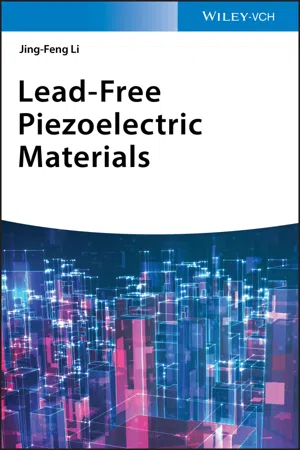
- English
- ePUB (mobile friendly)
- Available on iOS & Android
Lead-Free Piezoelectric Materials
About This Book
Provides in-depth knowledge on lead-free piezoelectrics - for state-of-the-art, environmentally friendly electrical and electronic devices!
Lead zirconate titanate ceramics have been market-dominating due to their excellent properties and flexibility in terms of compositional modifications. Driven by the Restriction of Hazardous Substances Directive, there is a growing concern on the toxicity of lead. Therefore, numerous research efforts were devoted to lead-free piezoelectrics from the beginning of this century. Great progress has been made in the development of high-performance lead-free piezoelectric ceramics which are already used, e.g., for power electronics applications.
Lead-Free Piezoelectric Materials provides an in-depth overview of principles, material systems, and applications of lead-free piezoelectric materials. It starts with the fundamentals of piezoelectricity and lead-free piezoelectrics. Then it discusses four representative lead-free piezoelectric material systems from background introduction to crystal structures and properties. Finally, it presents several applications of lead-free piezoelectrics including piezoelectric actuators, and transducers. The challenges for promoting applications will also be discussed.
- Highly attractive: Lead-free piezoelectrics address the growing concerns on exclusion of hazardous substances used in electrical and electronic devices in order to protect human health and the environment
- Thorough overview: Covers fundamentals, different classes of materials, processing and applications
- Unique: discusses fundamentals and recent advancements in the field of lead-free piezoelectrics
Lead-Free Piezoelectric Materials is of high interest for material scientists, electrical and chemical engineers, solid state chemists and physicists in academia and industry.
Frequently asked questions
Information
1
Fundamentals of Piezoelectricity
1.1 Introduction
Table of contents
- Cover
- Table of Contents
- Title Page
- Copyright Page
- About the Author
- Foreword by Professor Longtu Li
- Foreword by Professor Jürgen Rödel
- Preface
- 1 Fundamentals of Piezoelectricity
- 2 High‐Performance Lead‐Free Piezoelectrics
- 3 (K,Na)NbO3 System
- 4 (Bi1/2Na1/2)TiO3 System
- 5 BaTiO3 System
- 6 BiFeO3 System
- 7 Applications
- Index
- End User License Agreement